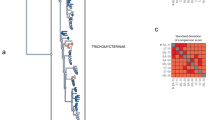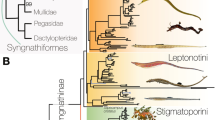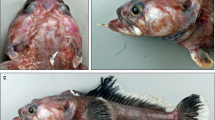Abstract
Statistical phylogenetic analyses of 111 5.8S and partial-28S ribosomal DNA sequences (total aligned length=434 nucleotides) including jellyfishes representing approximately 14 of known scyphozoan morphospecies (21 genera, 62 families, and 100 orders) are presented. These analyses indicate stauromedusae constitute a fifth cnidarian class (Staurozoa) basal to a monophyletic Medusozoa (=Cubozoa, Hydrozoa, and Scyphozoa). Phylogenetic relationships among the medusozoans are generally poorly resolved, but support is found for reciprocal monophyly of the Cubozoa, Hydrozoa, Coronatae, and Discomedusae (=Semaeostomeae + Rhizostomeae). In addition, a survey of pairwise sequence differences in Internal Transcribed Spacer One within morphospecies indicates that scyphozoan species diversity may be approximately twice recent estimates based on morphological analyses. These results highlight difficulties with traditional morphological treatments including terminology that obfuscates homologies. By integrating molecular phylogenetic analyses with old and new morphological, behavioural, developmental, physiological, and other data, a much richer understanding of the biodiversity and evolution of jellyfishes is achievable.
Similar content being viewed by others
References
S. F. Altschul T. L. Madden A. A. Schäffer J. Zhang Z. Zhang W. Miller D. J. Lipman (1997) ArticleTitleGapped BLAST and PSI-BLAST: a new generation of protein database search programs Nucleic Acids Research 25 3389–3402 Occurrence Handle10.1093/nar/25.17.3389 Occurrence Handle9254694 Occurrence Handle1:CAS:528:DyaK2sXlvFyhu7w%3D
M. N. Arai (1997) A Functional Biology of Scyphozoa Chapman & Hall London
N. Bax J. T. Carlton A. Mathews-Amos R. L. Haedrich F. G. Howarth J. E. Purcell A. Rieser A. Gray (2001) ArticleTitleThe control of biological invasions in the world’s oceans Conservation Biology 15 1234–1246 Occurrence Handle10.1046/j.1523-1739.2001.99487.x
H. B. Bigelow (1904) ArticleTitleMedusae from the Maldive Islands Bulletin of the Museum of Comparative Zoology at Harvard 39 245–269
H. B. Bigelow (1909) ArticleTitleReports on the scientific results of the expedition to the eastern tropical Pacific in charge of Alexander Agassiz by the U.S. Fish Commission Steamer ‘‘Albatross’’ from October 1904 to March 1905, Lieut. Commander L. M. Garrett, U. S. N., Commanding Memoirs of the Museum of Comparative Zoology at Harvard College 37 1–243
J. Bouillon (1999) Hydromedusae D. Boltovskoy (Eds) South Atlantic Zooplankton Backhuys Leiden 385–465
D. Bridge C. W. Cunningham B. Schierwater R. DeSalle L. W. Buss (1992) ArticleTitleClass-level relationships in the Phylum Cnidaria: evidence from mitochondrial genome structure Proceedings of the National Academy of Science of the USA 89 8750–8753 Occurrence Handle1:CAS:528:DyaK38XmtlSms7o%3D
D. Bridge C. W. Cunningham R. DeSalle L. W. Buss (1995) ArticleTitleClass-level relationships in the Phylum Cnidaria: molecular and morphological evidence Molecular Biology and Evolution 12 679–689 Occurrence Handle7659022 Occurrence Handle1:CAS:528:DyaK2MXmsVOqsLw%3D
R. C. Brusca G. J. Brusca (2003) Invertebrates, 2nd edn Sinauer Sunderland, Massachusetts
A. G. Collins (2002) ArticleTitlePhylogeny of Medusozoa and the evolution of cnidarian life cycles Journal of Evolutionary Biology 15 418–432 Occurrence Handle10.1046/j.1420-9101.2002.00403.x
K. A. Crandall O. R. P. Bininda-Emonds G. M. Mace R. K. Wayne (2000) ArticleTitleConsidering evolutionary processes in conservation biology Trends in Ecology and Evolution 15 290–295 Occurrence Handle10.1016/S0169-5347(00)01876-0 Occurrence Handle10856956
Dawson, M. N, 2005. Morphological variation and taxonomy in the Scyphozoa. Mastigas (Rhizostomeae, Mastigiidae) -- a golden unstandard. Hydrobiologia (in press).
M. N Dawson (2003) ArticleTitleMacro-morphological variation among cryptic species of the moon jellyfish, Aurelia (Cnidaria: Scyphozoa) Marine Biology 143 369–379 Occurrence Handle10.1007/s00227-003-1070-3
M. N Dawson D. K. Jacobs (2001) ArticleTitleMolecular evidence for cryptic species of Aurelia aurita (Cnidaria, Scyphozoa) Biological Bulletin 200 92–96 Occurrence Handle11249217 Occurrence Handle1:STN:280:DC%2BD3Mzgt1Snsg%3D%3D
M. N Dawson L. E. Martin (2001) ArticleTitleGeographic variation and ecological adaptation in Aurelia (Scyphozoa: Semaeostomeae): some implications from molecular phylogenetics Hydrobiologia 451 259–273
M. N Dawson W. M. Hamner (2003) ArticleTitleGeographic variation and behavioral evolution in marine plankton: the case of Mastigias (Scyphozoa: Rhizostomeae) Marine Biology 143 1161–1174 Occurrence Handle10.1007/s00227-003-1070-3
M. N Dawson K. A. Raskoff D. K. Jacobs (1998) ArticleTitlePreservation of marine invertebrate tissues for DNA analyses Molecular Marine Biology and Biotechnology 7 145–152 Occurrence Handle11541322 Occurrence Handle1:CAS:528:DyaK1cXjslCrsr0%3D
A. Franc (1995) Classe des scyphozoaires D. Doumenc (Eds) Traité de Zoologie: Anatomie, Systématique, Biologie volume III, fascicule 2: Cnidaires Cténaires Masson Paris 597–884
D. J. Futuyma (1998) Evolutionary Biology, 3rd edn Sinauer Sunderland, Massachusetts
E. Haeckel (1879) Das System der Medusen: Erster Theil einer Monographie der Medusen Gustav Fischer Jena
M. E. Hellberg (1996) ArticleTitleDependence of gene flow on geographic distance in two solitary corals with different larval dispersal capabilities Evolution 50 1167–1175
Holland, B. S., M. N Dawson, G. L. Crow & D. K. Hofmann, in press. Global phylogeography of Cassiopea (Scyphozoa: Rhizostomae): molecular evidence for cryptic species and multiple Hawaiian invasions. Marine Biology.
N. Knowlton (2000) ArticleTitleMolecular genetic analyses of species boundaries in the sea Hydrobiologia 420 73–90 Occurrence Handle10.1023/A:1003933603879 Occurrence Handle1:CAS:528:DC%2BD3cXktlSktLw%3D
P. L. Kramp (1961) ArticleTitleSynopsis of the medusae of the world Journal of the Marine Biological Association of the United Kingdom 40 337–342
D.J. Lindsay Y. Furushima H. Miyake M. Kitamura J.H. Hunt (2004) ArticleTitleThe scyphomedusan fauna of the Japan Trench: Preliminary Results from a Remotely-operated vehicle Hydrobiologia 530/531 537–547 Occurrence Handle10.1007/s10750-004-2645-9
O. Maas (1907) ArticleTitleDie scyphomedusen Ergebnisse und Fortschritte der Zoologie 1 189–238
Marques, A. C. & A. G. Collins, in press. Cladistic analysis of Medusozoa and cnidarian evolution. Invertebrate Biology.
V. J. Martin (2004) ArticleTitlePhotoreceptors of cubozoan jellyfish Hydrobiologia 530/531 135–144 Occurrence Handle10.1007/s10750-004-2674-4 Occurrence Handle1:CAS:528:DC%2BD2MXhsVylu7s%3D
C. Massin T. Tomascik (1996) ArticleTitleTwo new holothurians (Echinodermata, Holothurioidae) from an anchialine lagoon of an uplifted atoll, Kakaban Island, East Kalimantan, Indonesia Raffles Bulletin of Zoology 44 157–172
A. G. Mayer (1910) Medusae of the World, III: the Scyphomedusae Carnegie Institution of Washington Washington DC
L. R. McCloskey L. Muscatine F. P. Wilkerson (1994) ArticleTitleDaily photosynthesis, respiration, and carbon budgets in a tropical marine jellyfish (Mastigias sp.) Marine Biology 119 13–22 Occurrence Handle10.1007/BF00350101
M. Medina A. G. Collins J. D. Silberman M. L. Sogin (2001) ArticleTitleEvaluating hypotheses of basal animal phylogeny using complete sequences of large and small subunit rRNA Proceedings of the National Academy of Sciences of the USA 98 9707–9712 Occurrence Handle10.1073/pnas.171316998 Occurrence Handle11504944 Occurrence Handle1:CAS:528:DC%2BD3MXmtlCmsrw%3D
H. W. Mianzan P. F. S. Cornelius (1999) Cubomedusae and scyphomedusae D. Boltovskoy (Eds) South Atlantic Zooplankton I. Backhuys Leiden 513–559
C. E. Mills (2001) ArticleTitleJellyfish blooms: are populations increasing globally in response to changing ocean conditions Hydrobiologia 451 55–68 Occurrence Handle10.1023/A:1011888006302
C. Moritz (1994) ArticleTitleDefining ‘evolutionary significant units’ for conservation Trends in Ecology and Evolution 9 373–375
S. E. Murray-Jones D. J. Ayre (1997) ArticleTitleHigh levels of gene flow in the surf bivalve Donax deltoides (Bivalvia: Donacidae) on the east coast of Australia Marine Biology 128 83–89 Occurrence Handle10.1007/s002270050071
D. V. Naumov (1961) ArticleTitleStsifoidnye meduzy morei SSSR (Scyphomedusae of the seas of the USSR) Opredelitel: po Faune SSSR 75 1–98
M. Omori E. Nakano (2001) ArticleTitleJellyfish fisheries in southeast Asia Hydrobiologia 451 19–26 Occurrence Handle10.1023/A:1011879821323
K. W. Petersen (1979) Development of coloniality in Hydrozoa C. Larwood B. R. Rosen (Eds) Biology and Systematics of Colonial Organisms Academic Press New York 105–139
K. A. Pitt M. J. Kingsford (2000) ArticleTitleGeographic separation of stocks of the edible jellyfish, Catostylus mosaicus (Rhizostomeae) in New South Wales, Australia Marine Ecology Progress Series 196 143–155
D. Posada K. A. Crandall (1998) ArticleTitleModeltest: testing the model of DNA substitution Bioinformatics 14 817–818 Occurrence Handle10.1093/bioinformatics/14.9.817 Occurrence Handle9918953 Occurrence Handle1:CAS:528:DyaK1MXktlCltw%3D%3D
P. R. Pugh (1999) Siphonophorae D. Boltovskoy (Eds) South Atlantic Zooplankton Backhuys Leiden 467–511
Rambaut, A., 1996. Se-Al: Sequence Alignment Editor, Version 1.0 Alpha 1. http://evolve.zoo.ox.ac.uk/Se-Al/Se-Al.html.
F. S. Russell (1970) The Medusae of the British Isles. II. Pelagic Scyphozoa with a Supplement to the First Volume on Hydromedusae Cambridge University Press Cambridge
L.v. Salvini-Plawen (1978) ArticleTitleOn the origin and evolution of the lower Metazoa Zeitschrift für Zoologische Systematik und Evolution Forschung 16 40–48
L.v. Salvini-Plawen (1987) ArticleTitleMesopsammic Cnidaria from Plymouth (with systematic notes) Journal of the Marine Biological Association of the United Kingdom 67 623–637 Occurrence Handle10.1017/S0025315400027338
P. Schuchert (1998) ArticleTitleHow many hydrozoan species are there? Zoologische Verhandelingen Leiden 323 209–219
I. Stewart (2003) ArticleTitleHow the species became New Scientist 180 32–35
G. Stiasny (1921) Studien über rhizostomeen E. D. van Oort (Eds) Capita Zoologica Martinus Nijhoff Gravenhage, The Netherlands
K. Strimmer A. von Haeseler (1996) ArticleTitleQuartet puzzling: a quartet maximum likelihood method for reconstructing tree topologies Molecular Biology and Evolution 13 964–969 Occurrence Handle1:CAS:528:DyaK28XltlSmsLk%3D
D. L. Swofford (2002) PAUP*: Phylogenetic Analysis Using Parsimony (*and Other Methods), v.4.0b10 Sinauer Sunderland, Massachusetts
A. R. Templeton (1989) The meaning of species and speciation: a genetic perspective D. Otte J. A. Endler (Eds) Speciation and its Consequences Sinauer Sunderland, Massachusetts 3–27
T. Uchida (1926) ArticleTitleThe anatomy and development of a rhizostome medusa, Mastigias papua L. Agassiz, with observations on the phylogeny of Rhizostomae . Journal of the Faculty of Science Tokyo University Section IV–Zoology 1 45–95
T. Uchida (1947) ArticleTitleSome medusae from the central Pacific Journal of the Faculty of Science Hokkaido University series IV–Zoology 9 297–319
R. S. Waples (1987) ArticleTitleA multispecies approach to the analysis of gene flow in marine shore fishes Evolution 41 385–400
B. Werner (1975) ArticleTitleBau und Lebensgeschichte des Polypen von Tripedalia cystophora (Cubozoa, class. nov., Carybdeidae) und seine Bedeutung für die Evolution der Cnidaria Helgoländer Wissenschaftliche Meeresuntersuchungen 27 461–504
D. Wrobel C. Mills (1998) Pacific Coast Pelagic Invertebrates–A Guide to the Common Gelatinous Animals Sea Challengers and the Monterey Bay Aquarium Monterey
Author information
Authors and Affiliations
Corresponding author
Rights and permissions
About this article
Cite this article
Dawson, M.N. Some implications of molecular phylogenetics for understanding biodiversity in jellyfishes, with emphasis on Scyphozoa. Hydrobiologia 530, 249–260 (2004). https://doi.org/10.1007/s10750-004-2659-3
Issue Date:
DOI: https://doi.org/10.1007/s10750-004-2659-3




